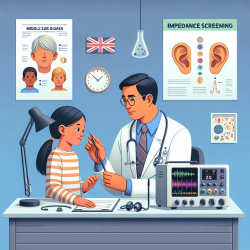Impedance screening has emerged as a pivotal tool in the early detection and management of middle-ear diseases in children, offering a non-invasive method to assess the health of the middle ear system. The significance of this tool, particularly in educational settings, cannot be overstated, given the critical role of hearing in language development and learning. Drawing on the insights from the symposium proceedings documented in "Impedance Screening for Middle-Ear Diseases in Children," this blog aims to illuminate the application of impedance screening in children and encourage further research and skill enhancement among practitioners.
Impedance audiometry, or tympanometry, measures the mobility of the eardrum and middle ear structures in response to pressure changes, providing valuable information about middle ear function. This technique is especially useful in pediatric audiology, where traditional behavioral hearing tests may be challenging to administer due to the young age or developmental status of the child.
Key Takeaways from the Symposium:
- The need for further research to refine impedance screening guidelines and recommendations was emphasized, particularly in correlating otoscopic findings with tympanometry results.
- Impedance screening's role in identifying middle ear diseases early can lead to timely intervention, potentially mitigating long-term impacts on hearing and language development.
- Challenges in the application of tympanometry in infants under three months old were highlighted, pointing to the need for age-specific strategies and methodologies.
- The symposium underscored the variability in tympanometry's effectiveness based on age, with preschool-age children showing more reliable results compared to infants.
Enhancing Practice through Research:
For practitioners, especially those working within educational settings, the implications of these findings are profound. By integrating impedance screening into routine hearing health assessments, audiologists and educational professionals can better identify children at risk for middle-ear diseases, ensuring that necessary interventions are implemented promptly. However, the symposium's findings also call for a deeper engagement with research to overcome current limitations and enhance screening accuracy, particularly in younger populations.
Encouraging Further Research:
The symposium proceedings not only provide a foundation for current practices but also highlight the gaps in our understanding of impedance screening's full potential. As practitioners, engaging with ongoing research, participating in further studies, and contributing to the evolving guidelines can enhance our ability to serve our pediatric populations effectively. Moreover, fostering a culture of inquiry and continuous learning within audiology and special education settings can lead to innovative approaches that improve outcomes for children with hearing and communication challenges.
In conclusion, "Impedance Screening for Middle-Ear Diseases in Children" serves as a critical resource for audiologists and educators alike, offering insights into the complexities of hearing health in young children and the importance of early detection and intervention. By embracing the recommendations and acknowledging the limitations outlined in the symposium, practitioners can significantly contribute to the advancement of pediatric audiology and the well-being of the children they serve.
To further explore the detailed findings and recommendations from the symposium, please follow this link: Impedance Screening For Middle-Ear Diseases in Children.










